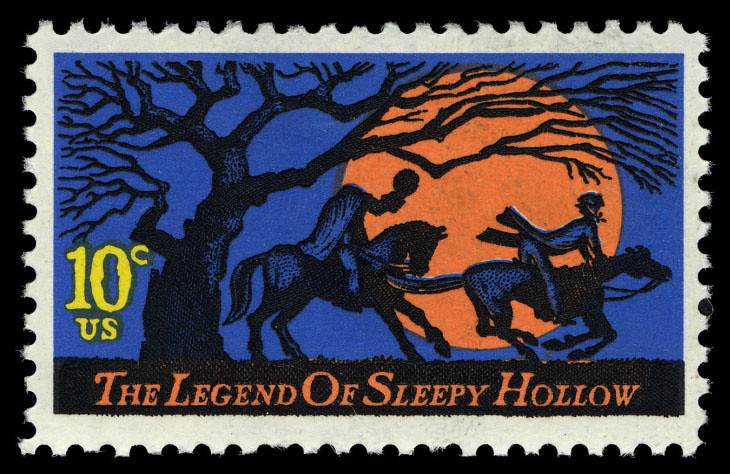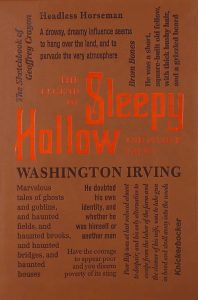
Welcome to my monthly book recommendation for February! Every month, I recommend a book that I’ve personally read and find worthwhile enough to recommend to my own readers. In each post, I’ll introduce the book, discuss why I found reading it worthwhile, and the major themes the book touches upon. I won’t include any major spoilers, but I may discuss some of the characters and specific details or locations from within the book.
My recommendation for February 2025 is The Legend of Sleepy Hollow and Other Tales, a compilation of stories by Washington Irving.
The Legend of Sleepy Hollow and Other Tales
Available on Amazon
 Author: Washington Irving
Author: Washington Irving
Genres: Fiction
Description:
The Headless Horseman faces off with Ichabod Crane in “The Legend of Sleepy Hollow,” a ghost story of enduring popularity that takes place at the time of the American Revolution. “Rip Van Winkle,” another traditional favorite from the same historic period, tells the tale of man who fell asleep for twenty years and found his small town in the Catskill Mountains much changed by the time he awakened. Both are included—along with many other tales—in this classic collection by Washington Irving.
My Thoughts
I found this book serendipitously during a day of travel, most of which was filled reading Dracula, my previous monthly book recommendation. The title caught my eye, and both the name of the featured story, The Legend of Sleepy Hollow, and the author, Washington Irving, piqued my interest, as I’d heard of both many years ago but never read either. Featured in the book is the story of Rip Van Winkle, famous the world over, but again, one which I’d never read. I’ve been working on expanding upon the types of books I read, and this presented me with the perfect opportunity to do so, so I took it.
Irving has a unique, interesting writing style, one which differs from what I’d expect. It presents itself as easygoing, effortless, carefree even, to the point where reading it has an immediately relaxing effect. His use of vocabulary and manner of expression strikes a solid balance between sophistication and accessibility. This writing style lends itself well to the subjects and backdrops of his stories, which often consist of a reflection of times bygone in a setting of natural beauty.
As I was reading these short stories, I came to appreciate his stories’ vivid, almost poetic portrayals of nature’s serenity. In some, they are the focus of the stories themselves, and in others, serve as the perfect backdrop for the stories that unfold among them. His characters often find themselves contemplating, or perhaps daydreaming of people known and times bygone, and Irving’s poetic attention to nature’s splendor entices us into our own reverie, parallel to that of the characters’.
Not all of his stories are rooted in beauty and tranquility. The editors of this book chose to focus those stories primarily in the middle of the book, leaving the beginning and end to focus on more serious topics, such as death, decay, and in some stories, the supernatural. Irving’s style of writing remains effective, portraying some of the most heartbreaking aspects of the human condition while maintaining his usual craftsmanship and ease of expression. I find this sampling of his works to be a solid sampling of his works, providing us a selection over a wide range of topics and sentiments.
Washington Irving originally published The Legend of Sleepy Hollow in 1820, and the rest of the stories in this compilation were from the same era. This marks the oldest author I’ve featured in a monthly book recommendation. When you read a book that’s older than, let’s say, sixty years, you’re effectively looking at the world through the lens of an era bygone. That lens brings visibility to customs, beliefs, old misconceptions, and cultural artifacts from a place in time that feels and behaves entirely differently than our own. These characters and their shared culture, roughly two hundred years old, are still entirely recognizable, but there are some interesting differences in behavior and dialogue.
There’s also an interesting phenomenon that arises from Irving’s own reflections to his past, to eras bygone even from his perspective: we, as readers, get to see prior times through a double-lens, something that is uniquely possible for us due to our own position in time. These stories hold value to us much differently than they did to those who originally read them. I believe there is a unique benefit to reading books from decades and centuries ago, especially those whose language are still easily accessible to us now, in that it provides an unfiltered glimpse into the past of the human condition.
While works from the past offer us art in a form that we’ll never quite be able to reproduce, they aren’t without blemish. I did spot a few instances of antiquated thinking, thinking that our culture has since evolved beyond. This is inevitable when reading authors from earlier centuries and even serves as a benchmark against which we can compare our progress since. I hope that readers two hundred years from now will look back at our newly published books and think the same. What a dismal state society would be in two hundred years from now if this weren’t the case.